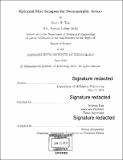| dc.contributor.advisor | Jeehwan Kim. | en_US |
| dc.contributor.author | Tan, Scott H. (Scott Howard) | en_US |
| dc.contributor.other | Massachusetts Institute of Technology. Department of Mechanical Engineering. | en_US |
| dc.date.accessioned | 2018-10-22T18:44:55Z | |
| dc.date.available | 2018-10-22T18:44:55Z | |
| dc.date.copyright | 2018 | en_US |
| dc.date.issued | 2018 | en_US |
| dc.identifier.uri | http://hdl.handle.net/1721.1/118687 | |
| dc.description | Thesis: S.M., Massachusetts Institute of Technology, Department of Mechanical Engineering, 2018. | en_US |
| dc.description | Cataloged from PDF version of thesis. | en_US |
| dc.description | Includes bibliographical references (pages 59-68). | en_US |
| dc.description.abstract | Intelligent machines could help to facilitate language translation, maximize attentive learning, and optimize medical care. However, hardware to train and deploy Al systems are power-hungry and too slow for many applications. Neuromorphic arrays could potentially offer better efficiency compared to conventional hardware by storing high-precision analog weights between digital processors. However, neuromorphic arrays have not experimentally demonstrated learning accuracy comparable to conventional hardware due to irreproducibility associated with existing artificial synapses. Large variation arises in conventional devices due to the stochastic nature of metal movement through an amorphous synapse. Hence, passive arrays have only been demonstrated as small-scale systems. In this thesis, I developed single-crystalline Silicon-Germanium (SiGe) artificial synapses that have suitable properties for large-scale neurormorphic arrays. In contrast to amorphous films, epitaxially-grown SiGe can confine metal filaments within widened threading dislocations for uniform conductance update thresholds. Metal confinement reduces temporal variation to as low as 1%, which is the lowest variation reported to date, to the extent of the author's knowledge. Dislocations are selectively etched to allow for high ON/OFF ratio, good retention, many cycles of endurance, and linear conductance change. Simulations accounting for non-ideal device properties suggest that SiGe synapses in passive crossbar arrays could perform supervised learning for handwriting digit recognition with up to 95.1% accuracy. Hence, SiGe synapses demonstrate great promise for large-scale neuromorphic arrays. | en_US |
| dc.description.statementofresponsibility | by Scott H. Tan. | en_US |
| dc.format.extent | 68 pages | en_US |
| dc.language.iso | eng | en_US |
| dc.publisher | Massachusetts Institute of Technology | en_US |
| dc.rights | MIT theses are protected by copyright. They may be viewed, downloaded, or printed from this source but further reproduction or distribution in any format is prohibited without written permission. | en_US |
| dc.rights.uri | http://dspace.mit.edu/handle/1721.1/7582 | en_US |
| dc.subject | Mechanical Engineering. | en_US |
| dc.title | Epitaxial SiGe synapses for neuromorphic arrays | en_US |
| dc.title.alternative | Epitaxial Silicon-Germanium synapses for neuromorphic arrays | en_US |
| dc.type | Thesis | en_US |
| dc.description.degree | S.M. | en_US |
| dc.contributor.department | Massachusetts Institute of Technology. Department of Mechanical Engineering | |
| dc.identifier.oclc | 1056953206 | en_US |
